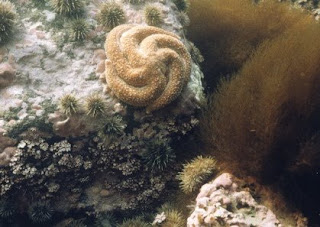ha! Well, ask an ye shall receive!!!
These are a follow up to the last post and are taken from various papers by Bingham et al. (2004), Foltz et al. (2008) and Pearse & Beauchamp (1986). The best known Leptasterias spp. are the Leptasterias "hexactis" forms from the west coast of North America and Leptasterias polaris in the Arctic/North Atlantic..
Leptasterias broods! From the big Arctic L. polaris to the tiny subArctic L. "hexactis" forms...
- The California forms brood from Jan-Feb-March-April and take 6-8 weeks to develop.
- Larger adults produce larger embryos- a doubling of arm radius in brooding females resulted in a 3 to 4 fold increase in egg production.
- Larger females produce more eggs but have a harder time carrying them completely through the brooding season.
- If "quality" and success is related to overall egg volume, then its possible that egg volume an size is possibly a predictor of survival to the juveniles.
The Leptasterias "hexactis" posture......
(from Chia, 1966)
The Leptasterias polaris posture.... (from this website..)
(from this website..)
What does Leptasterias eat? Mostly mollusks, barnacles and such...
 How long has Leptasterias been around?
How long has Leptasterias been around?
 Based on some recent work by Dave Foltz and colleagues (including myself) we used several gene markers to estimate how recently the various sister species of Leptasterias diverged!
Based on some recent work by Dave Foltz and colleagues (including myself) we used several gene markers to estimate how recently the various sister species of Leptasterias diverged!
So, all basically, all of the 'species complex' stuff I wrote about earlier? When did that happen?
That usually suggests a relatively recent speciation time frame. They diversified/speciated/or whatever you want to call it, ONLY about 0.5 to 1.2 Millions of Years Ago (Mya)!
Geologically, that's quite young..but put this into context for people reading this? This starfish likely speciated in the Pleistocene. What else happened in the Pleistocene?
There were glaciers. A LOT of them. Some 30% of Earth was covered by ice.
 How long has Leptasterias been around?
How long has Leptasterias been around? Based on some recent work by Dave Foltz and colleagues (including myself) we used several gene markers to estimate how recently the various sister species of Leptasterias diverged!
Based on some recent work by Dave Foltz and colleagues (including myself) we used several gene markers to estimate how recently the various sister species of Leptasterias diverged!So, all basically, all of the 'species complex' stuff I wrote about earlier? When did that happen?
That usually suggests a relatively recent speciation time frame. They diversified/speciated/or whatever you want to call it, ONLY about 0.5 to 1.2 Millions of Years Ago (Mya)!
Geologically, that's quite young..but put this into context for people reading this? This starfish likely speciated in the Pleistocene. What else happened in the Pleistocene?
 |
|
What else was alive in the Pleistocene? (Images from Wikipedia)




No comments:
Post a Comment